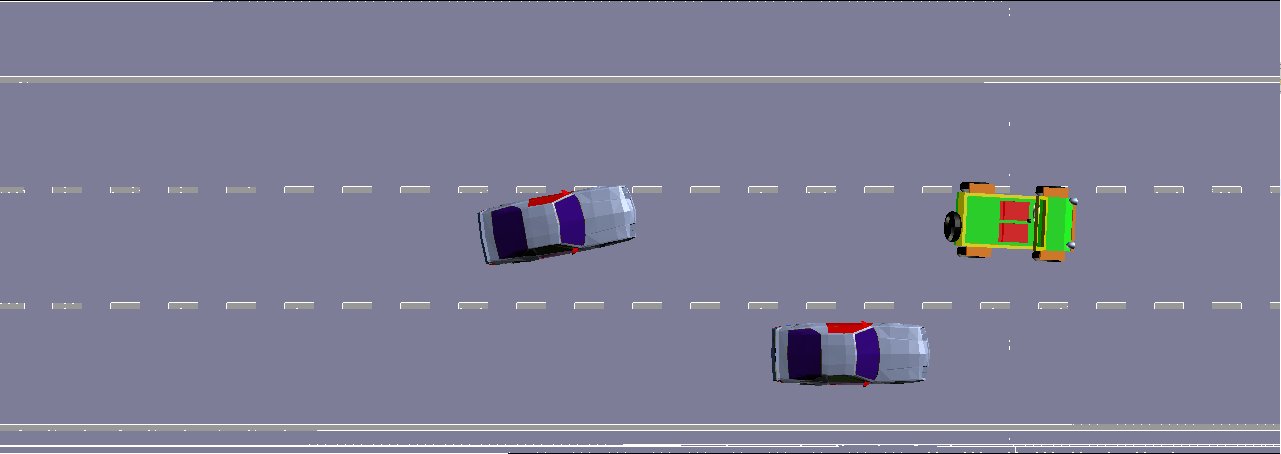Anticipation of Driver Behavior
Thesis by: Marek OrschewskiAdvisor: Marcus Tönnis
Supervision by: Gudrun Klinker
Due date: Spring/Summer 2006
Abstract
Advanced Driver Assistance Systems (ADAS) are a very important feature for the car industry. Their task is to make driving safer and more convenient. New, more intelligent ADAS systems (e.g. Adaptive Cruise Control System - ACC) will be rejected by a driver if its behavior is not similar to his manner of driving. To improve the acceptance of such systems, the reaction of human drivers during various traffic situations has to be analyzed and compared to ADAS functionality. The developed system allows easy recording of virtual traffic scenarios. Afterwards these scenarios can be replayed and viewed from different perspectives in various environments (e.g. driving simulators). It offers the possibility to let a car driver experience such a scenario in the lab. His driving behaviour can be analyzed by psychologists and compared to analog ADAS data. To ease creation of scenarios for people with no former experience in traffic simulators and 3D-graphics a tracking system in combination with a backprojection table is used. It allows to steer a tracked car-body on a road shown on a workbench's surface and recording its trajectory. A recorded scenario can be viewed from different perspectives, for instance from a driver's point of view in a driving simulator. The main goal was to develop a tool to facilitate the generation of such scenarios, allowing laymen to learn how to create a scenario as easy as possible. The usability has been tested with persons not involved in the project. The result appears promising. Test persons were able to create their first simple traffic scenarios after working through a tutorial (taking about 40 minutes) within 20 minutes. Experienced users can generate a scenario of five cars in approximately 8 mins. To find out, how drivers react on traffic situations, we can use two approaches:
To find out, how drivers react on traffic situations, we can use two approaches:
- Record driver videos in real traffic until predefined situations occur
- Request drivers to generate traffic scenarios in a simulated environment (*)
- Replay previousely generated scenarios and record the own cars trajectory (*)
- Compare modified scenarios to determine the effect of changes within (e.g. other cars, colors, traffic density, ...) (*)
- Test subjects to develop traffic scenarios in a lab environment
- Replay generated or recorded scenarios to other test subjects
- Generated scenarios are developed in the lab environment
- Recorded scenarios come from real sensor data which is converted into a scenario

| Students.ProjectForm | |
|---|---|
| Title: | Anticipation of Driver Behavior |
| Abstract: | Advanced Driver Assistance Systems (ADAS) are a very important feature for the car industry. Their task is to make driving safer and more convenient. New, more intelligent ADAS systems (e.g. Adaptive Cruise Control System - ACC) will be rejected by a driver if its behavior is not similar to his manner of driving. To improve the acceptance of such systems, the reaction of human drivers during various traffic situations has to be analyzed and compared to ADAS functionality. The developed system allows easy recording of virtual traffic scenarios. Afterwards these scenarios can be replayed and viewed from different perspectives in various environments (e.g. driving simulators). It offers the possibility to let a car driver experience such a scenario in the lab. His driving behaviour can be analyzed by psychologists and compared to analog ADAS data. To ease creation of scenarios for people with no former experience in traffic simulators and 3D-graphics a tracking system in combination with a backprojection table is used. It allows to steer a tracked car-body on a road shown on a workbench's surface and recording its trajectory. A recorded scenario can be viewed from different perspectives, for instance from a driver's point of view in a driving simulator. The main goal was to develop a tool to facilitate the generation of such scenarios, allowing laymen to learn how to create a scenario as easy as possible. The usability has been tested with persons not involved in the project. The result appears promising. Test persons were able to create their first simple traffic scenarios after working through a tutorial (taking about 40 minutes) within 20 minutes. Experienced users can generate a scenario of five cars in approximately 8 mins. |
| Student: | Marek Orschewski |
| Director: | Gudrun Klinker |
| Supervisor: | Marcus Tönnis |
| Type: | SEP |
| Area: | |
| Status: | finished |
| Start: | 2006/10/15 |
| Finish: | 2007/07/24 |